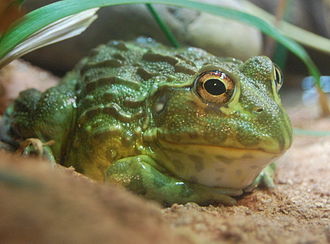| Place of Origin and Range |
The African bullfrog is also known as the pixie frog due to its Latin name. It is found in Angola, Botswana, Kenya, Malawi, Mozambique, Namibia, South Africa, Swaziland, Tanzania, Zambia, Zimbabwe, and possibly Democratic Republic of the Congo. |
| Description |
This bull frog has elongated skin and an olive green colour. Males have a yellow throat. These have a compact toad like body and a huge head. Adults can bite painfully. |
| Adult Size |
Can grow up to 8 in (20 cm) |
| Accommodation |
These frogs "prefer habitats with plentiful floating vegetation, grasses, and cattails" and are often found in "small ponds, large lakes, marshes, and streams also can be found at night in a backyard swimming pool. Unlike many amphibians, they do not require artificial heating. They need a large (at least ten-gallon) terrarium and do best with a substrate that will hold some humidity, such as commercial shredded bark or coconut husk bedding, or untreated topsoil on the floor of their terrarium. A shallow water dish should be included. Captive frogs should not be handled any more than necessary; when necessary, clean gloves should be worn. . A source of UV light is not required, and ambient temperature of 72 to 77 °F (22 to 25 °C) is sufficient.
|
| Lifespan |
Can live up to 45 years |
| Feeding / Diet |
The African bullfrog is carnivorous and a voracious eater, eating insects, small rodents, reptiles, small birds and other amphibians. |
| Breeding |
Breeding starts after heavy rain (initiated by 65 mm of rain over the previous day or two). They breed in shallow, temporary water bodies, such as pools, pans and ditches. Eggs are laid in the shallow edge of the pond, but fertilization takes place above water level. The African bullfrog males call out during the rainy season. The call lasts about a second and can be described as a deep low-pitched whoop. Males have two breeding strategies, depending on their age. Young males congregate in a small area, perhaps only 1 or 2 square meters of shallow water. The larger males occupy the centre of these breeding arenas or leks and attempt to chase off other males. Often they fight, causing injury and even killing one another. The dominant male attempts to prevent other males from breeding. A female approaches the group of males by swimming along at the surface until she is within a few meters of the group. Then the female dives to avoid the smaller males and surfaces in the defended area of a larger male in the middle of the group. This helps to ensure that she mates with the dominant male. The female lays about 3,000 to 4,000 eggs at a time. The tadpoles hatch and after two days start feasting on vegetation, small fish, invertebrates and even each other. Defending males will continue to watch over the tadpoles, which will metamorphose within three weeks. During the tadpole's development, the father guards his young. He will pounce and bite anything that he views as a threat. If the pool is in danger of drying out, the father will use his legs and head to dig a canal from the drying pond to a bigger pond. He will continue to guard the tadpoles until they are old enough to fend for themselves, although he may also eat some of them. |




